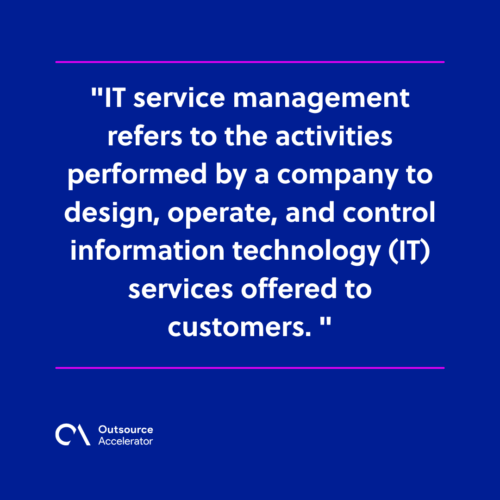An introduction to IT service management

IT service management (ITSM) is crucial in ensuring seamless operations and reliable technology infrastructure in business. The process allows organizations to enhance their efficiency and optimize productivity.
IT service management serves as a guiding framework that aligns IT functions with the overarching goals of an organization. This system fosters a proactive and customer-centric approach.
In this article, we’ll enter the world of IT service management, exploring its significance, core principles, benefits, and applications.
How IT service management works
IT service management refers to the activities performed by a company to design, operate, and control information technology (IT) services offered to customers. It encompasses all planning, implementing, and optimizing IT services to meet end-user needs.
The primary goal of IT service management is to align IT services with the overall business objectives and needs.
The mechanism involves establishing efficient and standardized processes and frameworks for managing the life cycle of IT services. This covers their conception and design to deployment, operation, and continual improvement.

IT service management vs. IT infrastructure library
IT service management and IT infrastructure library (ITIL) are related concepts but have distinct differences in the following areas:
| ITSM | ITIL | |
| Scope | Encompasses the overall management and delivery of IT services | Focuses specifically on best practices for implementing ITSM effectively |
| Framework and concept | Represents the overarching concept and philosophy of managing IT services to meet business goals | Serves as a set of guidelines used in the execution of ITSM |
| Relationship | Can incorporate other frameworks and methodologies, including ITIL | Falls under the umbrella of ITSM |
| Flexibility | Allows for flexibility in choosing frameworks that suit specific needs | Provides a structured and prescriptive set of practices |
IT service management vs. DevOps
IT service management and DevOps are two different approaches to managing IT operations. Here are the key differences between the two strategies:
| ITSM | DevOps | |
| Focus and objective | Focuses on managing IT services in alignment with business goals | Focuses on collaboration and integration of development and operations to streamline software delivery |
| Scope | Covers the entire lifecycle of IT services | Has a narrower focus on optimizing software development and delivery processes |
| Principles and culture | Follows a more structured and sequential workflow with a well-established and mature culture | Promotes a collaborative and integrated workflow; introduces a cultural shift that breaks down silos |
| Approach to change | Associated with a controlled and stable approach to change management | Encourages a more agile and iterative approach to change |
Importance of IT service management
The most prominent reason IT service management is important is that it helps keep a company’s IT services aligned with its goals. It ensures that their IT services deliver value and enable efficiency.
This alignment is pivotal for organizations that seek to leverage technology as a strategic asset rather than a mere operational necessity.
Through effective IT service management, businesses can:
- Optimize resource utilization
- Enhance customer satisfaction
- Maintain agility
It acts as the linchpin that connects IT activities to the broader business objectives. Through this, it fosters a symbiotic relationship between technology and operational success.
IT service management processes
IT service management comprises a set of processes that play a vital role in delivering and supporting IT services.
Here are some commonly recognized ITSM processes:
Incident management
The incident management process focuses on restoring normal IT service operations as quickly as possible after an incident. It involves logging, categorizing, prioritizing, and resolving incidents to minimize their impact on business.
This process ensures that unexpected issues are addressed promptly, reducing downtime.
Problem management
Problem management aims to identify and resolve the root causes of recurring incidents to prevent future disruptions. This ITSM process involves investigating problems, categorizing them, and implementing permanent solutions.
By proactively addressing underlying issues, this process contributes to the overall stability and reliability of IT services.
Change management
Change management is essential for implementing modifications to IT services in a controlled and systematic manner. It ensures that changes are planned, assessed for impact and risk, and verified.
This ITSM process helps organizations adapt to evolving business requirements while maintaining stability and reliability in IT services.
Release and deployment management
Release and deployment management is concerned with software releases to the live production environment. It involves defining release strategies, coordinating release activities, and ensuring that proper testing and validation are performed.
This ITSM process ensures that new or modified services are deployed smoothly while minimizing the risk of adverse effects.
Release and deployment management contributes to maintaining the integrity of the IT environment and supporting business objectives.

Service level management
Service level management is responsible for defining and monitoring service level agreements (SLAs). These contracts ensure that IT services meet agreed-upon performance standards.
As part of IT service management, it involves continuously assessing service performance, negotiating new SLAs, and ensuring that service levels are met or exceeded.
Service level management aims to align IT services with the needs and expectations of customers.
Configuration management
Configuration management involves the systematic identification, control, and maintenance of configuration items within the IT infrastructure.
It includes processes like:
- Configuration identification
- Configuration control
- Status accounting
- Verification and audit
This ITSM process provides a complete understanding of the relationships and dependencies between various components.
This helps facilitate effective change management and ensures accurate documentation of the IT environment.
Service desk/request management
Service desk/request management is the ITSM process of providing a single point of contact for user requests. Users may seek assistance, report incidents, or find information.
This IT service management process aims to deliver excellent customer service and timely resolution of routine user issues.
An organization may have additional ITSM processes based on their specific requirements and industry best practices. It’s important to note that these processes are often interrelated and rely on each other to bring effective IT service management.
Benefits of IT service management
IT service management offers several benefits for organizations to effectively handle their IT services:
Clear service level agreements (SLAs)
IT service management helps companies bring high-quality services. It helps them define SLAs to set clear expectations, resulting in improved overall service delivery.
SLAs provide a basis for measuring and improving service quality, ensuring that IT services deliver what was discussed.
Enhanced customer satisfaction
IT service management focuses on promptly addressing customer issues and providing efficient support. It emphasizes a customer-centric approach through its primary processes.
By ensuring timely and effective resolution, organizations can enhance satisfaction and build customer loyalty.
Increased efficiency and productivity
IT service management promotes the standardization and automation of IT processes. This reduces manual efforts and streamlines IT operations.
Improved efficiency leads to quicker incident resolution, faster service delivery, and a more agile response to changes in the business environment.
Proactive problem management
IT service management includes proactive problem management processes to identify and resolve the root causes of recurring incidents.
This reduces the likelihood of repeating problems, contributing to a more stable and reliable IT environment.
Compliance and governance
IT service management often includes mechanisms to ensure compliance with industry regulations and standards.
Organizations can ensure that their IT services and processes adhere to regulatory requirements. This mitigates risks and maintains a strong governance framework.
These benefits contribute to improved IT service management and support organizations in achieving their business objectives and meeting customer needs.
Adopting ITSM principles can be a key driver for success in the ever-evolving digital landscape.
Examples of IT service management
IT service management has examples and applications across various industries, as the need for efficient IT service delivery and support is prevalent in all sectors.
Here are some examples of how ITSM is applied in different industries:
Healthcare
IT service management plays a crucial role in healthcare organizations. It’s used to manage IT services that support patient care, such as:
- Electronic health record (EHR) systems
- Medical imaging systems
- Clinical information systems
ITSM ensures the availability and security of critical healthcare applications. These support the overall delivery of quality patient care.
Finance and banking
In the banking and financial industry, IT service management enables the smooth operation of:
- Core banking systems
- Online banking platforms
- Payment processing
- Fraud detection systems
Incident management and quick response to security threats are paramount for maintaining customer trust.
Retail
IT service management assists the retail industry in operating IT services like the following:
- Point-of-sale systems
- Inventory management systems
- E-commerce platforms
- Customer relationship management (CRM) solutions
ITSM ensures that these systems are operational, safe, and compliant to provide uninterrupted service.
Manufacturing
IT service management in manufacturing ensures the smooth operation of production, supply chain management, and quality control systems.
It’s vital for implementing and controlling changes to production environments as well.

Education
In the education sector, IT service management is essential for managing student information systems, online learning platforms, and IT infrastructure across campuses.
ITSM processes help keep the system available to educators and students. In recent times, this has only grown due to remote learning initiatives.
Telecommunications
Telecommunications companies rely heavily on IT service management.
They oversee services like:
- Network infrastructure
- CRM systems
- Billing systems
- Service provisioning
ITSM is crucial for minimizing service disruptions and providing effective customer support.
Government
Government agencies utilize IT service management for citizen services, managing IT infrastructure, and ensuring the security of sensitive data.
ITSM processes also ensure that internal systems and administrative functions comply with government regulations. These establish and monitor service quality benchmarks.
These are just a few examples of how ITSM can deliver reliable IT services across different sectors.
The principles of IT service management are versatile and can be adapted to the unique requirements of various industries.
Invest in IT service management now
The case for investing in IT service management has never been more compelling. Widespread digital transformation is just around the corner, and companies will need ITSM to help navigate the accompanying complexities.
It’s a Good thing that aside from digital platforms ready to enhance IT services, there are also dedicated third-party service providers like Connext that focus on IT support and development.
The benefits are multifaceted, allowing businesses to fortify their IT operations. This produces a more stable and reliable IT environment and fosters a culture of continuous improvement and agility.
IT service management equips organizations with the tools to adapt to change, whether those changes come as:
- Technological advancements
- Shifts in market dynamics
- Evolving customer expectations
The time to invest in IT service management is now. It’s a mark of the future-readiness of your organization and a commitment to deliver high-quality IT services.







 Independent
Independent




